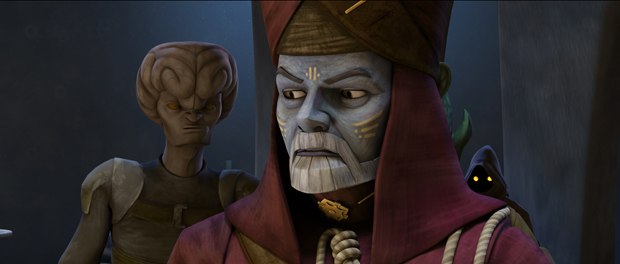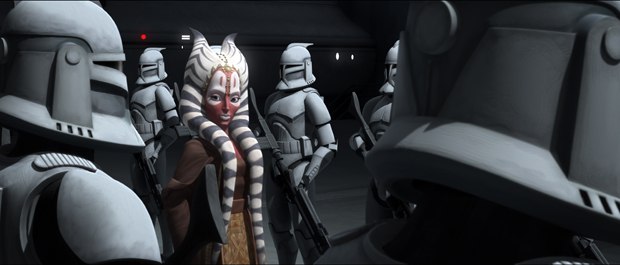Director Dave Filoni describes how the Star Wars series continues improving in both style and storytelling.
Check out the Clone Wars season three trailer and clip at AWNtv!
Star Wars: The Clone Wars has recently begun its third season on Cartoon Network on Fridays at 9:00 pm. In fact, the fourth episode, "Sphere of Influence," airs this week, featuring Papanoida (from Revenge of the Sith) who is modeled after creator George Lucas. This season "secrets are revealed, truths are questioned and alliances are betrayed," so director Dave Filoni fills us in on how the series has evolved.
Bill Desowitz: What's new in season three?
Dave Filoni: I think this season, more than any other, we have a much grander scope; we stopped avoiding things like water, which, as you know, can be very hard to sim and we attacked a lot of these things head on. Visually, I think it's far more stunning and really getting to the caliber that Star Wars fans are used to in the feature films. We've hit a stride and I'm pretty happy with the way things are looking. Storytelling wise, we learned so much after doing two seasons of this show. What we all liked; what we didn't like. And George has keenly been involved in that with the writers and me.
BD: How have you managed to raise the animation bar?
DF: I think it's the culmination of my artists becoming more experienced working together. I've been at Lucasfilm Animation for five years now and I have some really strong relationships with the artists here. My CG Supervisor, Joel Aron, is a 17-year veteran at Industrial Light & Magic, and he's brought a lot of trickery to The Clone Wars. He worked on A Perfect Storm, where they did an immense amount of water, so challenging him to bring that in a fashion to television was really fun for him, but the water planet, Kamino, which is where all the clones are born, we never could've done in the first two seasons because of the complexity of the environment. And now you're going to see the birth world of the clones in all its glory inside the barracks where they train; the massive battle where the Separatists attack the facilities; we under the water; we're over the water; we have crashing waves. It's all done in a way that the water will be the least thing that you recognize. It becomes a part of the story and a part of the planet, which is the best kind of effect.
Now we're on Kamino but it was about two seasons of figuring out how to attack this. We had to come up with a stylized look of water and Joel and I used a lot of N.C. Wyeth paintings, paintings that George has around the ranch, frankly. There was one painting, in particular, of these two rafters going down a whitewater in a canoe, and I would look at this with Joel and remark about how he painted the water and how this is how our water needs to look in the show. And then we watched a lot of anime and looked at how artists handled water, which is interesting for a CG show to not be as concerned with the photorealism: Akira had these incredible stylized explosions: the bridge scene where it falls into the water, and the water's erupting in these giant, white explosions.
BD: What else can we see more fully this season?
DF: Well, I think the environments as a whole and the improved facial expressions of the characters carry over from season two. The characters breathe more now, which is critical for a computer-animated show: to see air coming in and out of the body makes them look much more alive. So that's a big leap. And we also wanted to take the environments further. There's far more particles in the air. We're getting little details like trash on the ground; more of a softness to the environments, especially the organic environments. We're really challenging ourselves with organic environments to break some of the polygonic tendencies of the backgrounds and make these places feel lived in because that's something that Star Wars struck quite naturally: the lived in feeling of this galaxy, where you believed the depth of the histories from the way the costumes looked and the equipment was worn down. And now it rains anywhere we want and that came about from snow. Again, these are things when you are in the animation industry that you appreciate the level of attention going on.
BD: How have you improved the performances?
DF: Well, Carlo Sansonetti, who is the lead of my rigging department, has helped it dramatically changed over the years. The models haven't necessarily changed, but what's moving them -- the blend shapes in the faces -- has all changed. It's allowed a lot more softness over those angular character models that we make. We've also found ways to soften some of those edges where we were too harshly stylized in the beginning and it felt too wooden puppetry. Frankly, the best we can improve is to make an episode, access it, say what we like or don't like about it and then we try in the next episode to improve stuff. It's uncommon in my animation experience to have a TV production continually try to upgrade along the way. We're not in a one-season box. And Carlo and the gang have added a lot to the performances in the faces. And the actors have done a more robust job with their vocal performances. They put a lot more breaths and slight ad libs in, which allow the animators to grab onto a lot more.
BD: Where is the story going this season?
DF: Well, I have to say that this season, more than any other, George really came with some really incredible ideas, which, as a Star Wars fan, were exciting. We're going to deal with Anakin as the chosen one and getting into more of what that means. We're going to get back to the Clones and that they're not all the same. Right off the bat we come on strong with these two Kamino episodes where we see these Clones more in their daily life and training, more as the everyman, instead of the Jedi, which are more like the Knights of the Roundtable. People seem to really identity with the Clones and we challenge the perspective of them being this prefabricated army.
They become ARC Troopers, which is something new this season. It's an advanced type of trooper: Advanced Recon Commando. We get more into the bizarre side stories: I always call them the Jabba's palace stories. When I was a kid and would watch Return of the Jedi, it was almost two movies to me: Jabba's palace, which is this crazy Muppet show of riff-raff folks in the galaxy that are hiding from the Empire or working with it, just the colorful side of Star Wars. Then there was bleak Empire, which was very black-and-white and imperial. So we have new episodes with Ziro the Hut and Cad Bane. And all throughout season three we have these classic connections to the original trilogy. I'll keep those secret for now, but fans of the original movies will definitely see things and that's going to be really interesting and revealing along the way.
Bill Desowitz is senior editor of AWN & VFXWorld.










